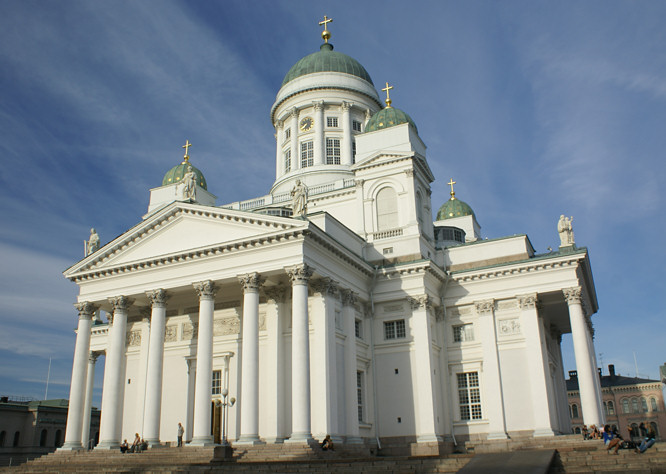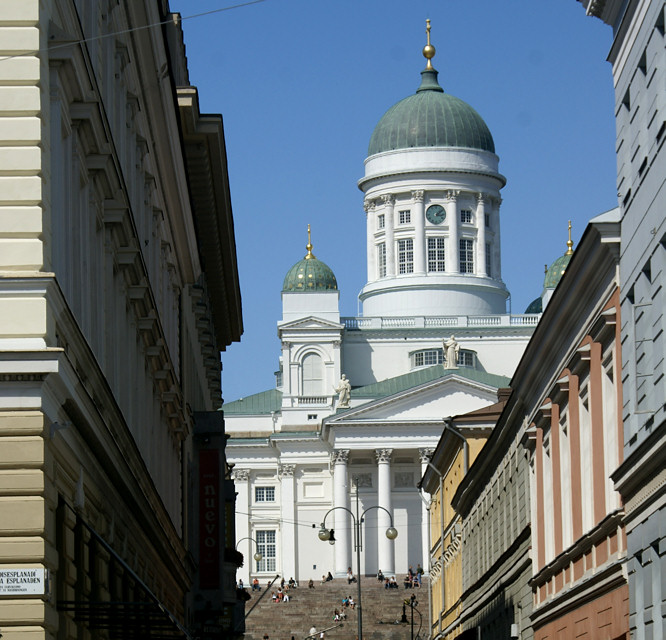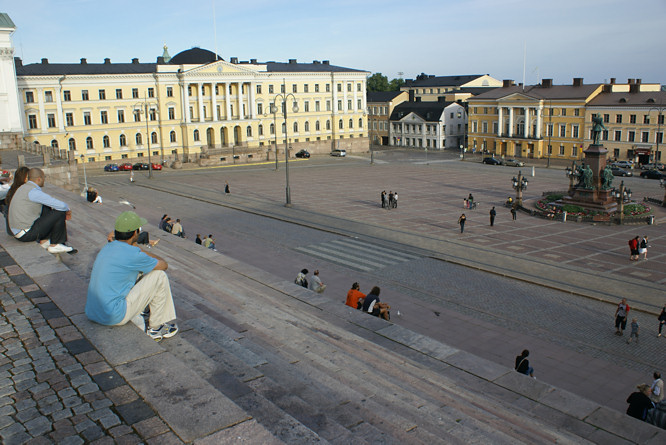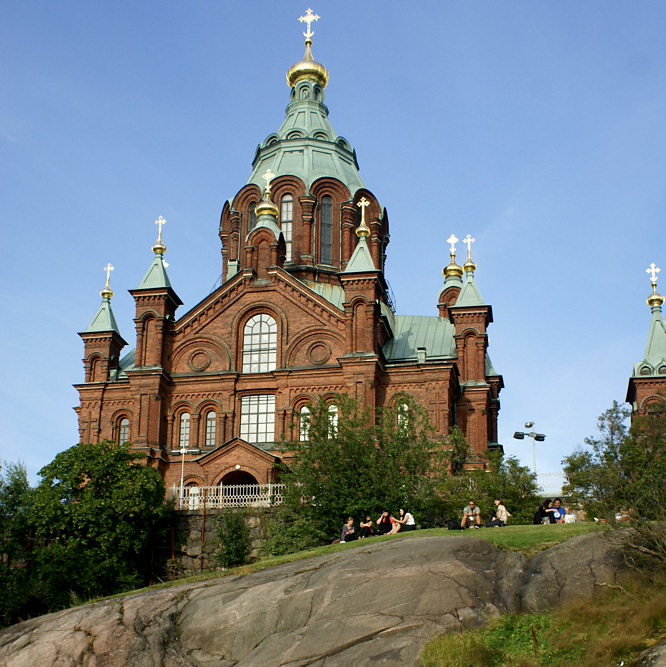Tuomiokirkko The white neoclassical Lutheran Cathedral of Helsinki
In the middle of Helsinki you will see the huge white cathedral called Tuomiokirkko. It is situated on a hill and makes a strong impression. The Five greenish domes, numerous Corinthian columns and a number of statues on a roof are visible from the sea. When you come into the town by ferry it is a very prominent landmark.

From the outside the church is amazing, with the long stairs that goes up to the gate, and the really white colour of the building. In front of the church there is a big square, the senate square, with a big statue in the middle. But if the outside is amazing, the inside of the church is the opposite.
The inside of the Cathedral seems large and spacious due to its high ceiling and white walls. The inside is plain, it is not the most interesting of churches as it holds few artworks. It is a typical Lutheran minimalist interior. But it's worth a trip inside, if nothing else for just feeling the atmosphere that always is there in this big churches. There are 3 statues of prominent protestant reformers including Mikael Agricola (a Finnish clergyman and the founder of written Finnish) and Martin Luther (a key leader of the Lutheran and Protestant reformations in Germany).
The painting that was originally intended for the altar portrayed the Christ blessing children. It was painted Robert Ekman and had delightful colours. The emperor did not however like the painting, so he decided to replace it with the one painted by a Russian artist T. K. von Neffin. It is rather dark and gloomy and it depicts the Christ being taken down from the cross. Around the corner you'll find the bus- and tram-stop, so it's easy to go somewhere else in Helsinki from the church. It's also just 5 minutes walk to the red, orthodox, church, and to the harbour, and to the train station.
My favourite part about visiting Tuomiokirkko was sitting on the steps leading up to the building and enjoying sitting in the summer sun and looking out across Senate Square. Tuomirkirkko is on top of a hill and can be viewed from most south-eastern parts of the city centre. The Cathedral looks particularly beautiful when it is lit up at night. Opening Hours: Mon-Sun 9am - 6pm During summer Mon - Sun: 9am - midnight

The church was conceptualized by German Carl Ludvig Engel, who started building it in 1830. After a fire destroyed most of Helsinki during Russian rule, the new city square was inaugurated as part of the 19th-century reconstruction. The Tuomiokirkko was built to replace a smaller 1727 church but Engel died in 1840 and work was taken over by Ernst Lohrmann who added the zinc statues of the twelve apostles on the roof, a bell tower, and a side chapel to Engel's design. The church was completed in 1852. Entrance is free and there is a cafe inside.
The Cathedral is constructed in style of neoclassicism, its height together with a dome makes 62 m, around of the central dome four small turrets are settled down (E.Lorlan). The roof is decorated by figures of 12 apostles (1849) It has had several names during its existence. It is currently known as the Helsinki Cathedral. It was also called St Nicolas's Church, after the ruler of the Russian empire, Nicolas I. The name was in use until the independence of Finland in 1917 and was changed because it reminded the newly independent country of its time under the rule of the mighty Russia.
The Statue of Tsar Alexander II is in front of the cathedral. The Cathedral dominates the square and probably because it draws so much attention. The rest of the square is totally different. On the opposite side of the Cathedral (on the lower side of the square) you can see many old houses built by merchants in the 18th century. They have been restored and now house City offices. On the ground floor of these houses there are little shops, cafes and restaurants as well as a few government buildings.

The Helsinki Red Church - Uspenski Orthodox Cathedral
To the right of Helsinki Harbour market, when looking from the sea, you will see a large red brick church on a rocky hill. It is the Uspenski Orthodox Cathedral of Helsinki. It was designed by Alexey Gornostaev (1808-1862) in a classic Orthodox style after a 16th century church in Kolomenskoje, near Moscow when Finland was part of the Russian Empire. The Orthodox faith was the earliest form of Christianity to arrive in Finland.

It spread to southern Finland through trade and missionaries from the East. The Uspenski Cathedral is the largest of its kind in Western Europe. The word Uspenski derives from a Slavic word 'uspenie', which means dying whilst sleeping which is a bit strange. The cathedral is dedicated to the Virgin Mary and it celebrates its festal day on 15 August, the day she died. It may not be as spectacular as some other orthodox cathedrals, like the one in Tallinn, but it has some beautiful interiors.
The cathedral is constructed of red bricks brought from Bomarsund fortress in Aland, destroyed during the Crimean War. It was consecrated in 1868. The shape of the building symbolizes the Holy Spirit who descended upon the apostles during Pentecost. The 13 golden onions represent the Christ and the twelve apostles. The dome is supported by 4 monolithic granite pillars. It is blue with stars on it. There are only a few chairs inside the church, since the congregation stands during the services.
The altar is positioned behind the wall of iconic pictures (Iconostasis) and it symbolises the heaven. Icons portray holy people and scenes from the bible. Each icon is dedicated a special day in the Orthodox liturgical year. There is also a chapel in the Cathedral, dedicated to Father Aleksander Hotovitski, murdered in 1937. The crypt chapel is the place for post-service coffee and hosts many exhibitions and events open for the public.
Opening Hours: May-Sep: Mon-Fri 9.30am-4pm; Sat 9.30am-2pm; Sun 12pm-3pm. Oct-Apr: Tue-Fri 9.30am-4pm; Sat 9.30am-2pm; Sun 12pm-3pm Entrance is free of charge.
Travel books

